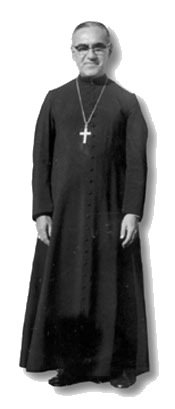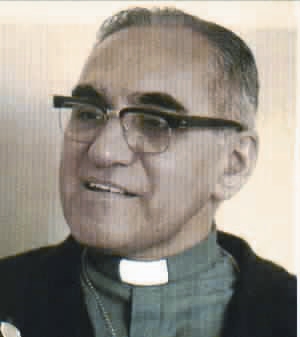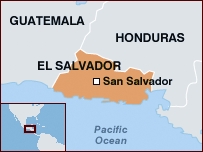Archbishop Romero Of El Salvador 1917-1980
A UN Truth Commission investigating in 1992 the murder of Archbishop Oscar Romero of San Salvador, El Salvador, concluded:
On Monday, 24 March 1980, the Archbishop of San Salvador, Monsignor Oscar Arnulfo Romero y Galdamez, was celebrating Mass in the Chapel of the Hospital de la Divina Providencia when he was killed by a professional assassin who fired a single .22 or .223 caliber bullet from a red, four-door Volkswagen vehicle. The bullet hit its mark, causing the Archbishop's death from severe bleeding.
Archbishop Romero
On 3 September 2004 Judge Oliver W. Wanger of the federal court in Fresno, California, USA, ruled that Alvaro Rafael Saravia, a retired Salvadoran air force captain, was culpable of Archbishop Romero’s death. Saravia, living in the USA for nearly 20 years, went underground about a year before the verdict. He was a member of a death squad of Major Roberto D’Aubuisson and involved in the planning of the assassination. He had ordered his driver to take the gunman in his car to the chapel. The UN Commission’s findings said that D’Aubuisson had given the order for the murder.
Who was Archbishop Romero?
Archbishop Oscar Arnulfo Romero y Galdamez stood up for human rights during the severe repression in El Salvador in the late 1970s. He became the leading voice for victims of the government and for the poor through his Sunday radio homilies, broadcast throughout the country, calling for an end to military repression. Those in power in El Salvador saw the archbishop as a threat to their political agenda.
The day before his assassination, Romero addressed his homily to government soldiers and pleaded, ‘In the name of God, in the name of these suffering people whose cries rise to heaven more loudly each day, I implore you, I beg you, I order you: Stop the repression.’
Romero was nominated for the Nobel Peace Prize in 1979 and is currently being considered by the Vatican for beatification.
Bishop Gregorio Rosa Chávez, auxiliary of El Salvador since 1982, said in an interview:
His last Mass in the hospital chapel was a Mass for the dead. Romero read the Gospel of John where Jesus says, ‘The hour has come that the Son of Man be glorified.’ I ask myself whether he knew in that moment that he was going to be killed. His sermon seems a testament, in which he compares himself with the grain of wheat which opens in the soil to give life. And so some people think that while he was preaching he saw his killer. Reading his last words, he almost seems to be asking the killer, ‘Allow me to die when I go to the altar to offer the bread and wine.’ And in fact he was able to finish his sermon and was killed at the start of the offertory, himself becoming the host of his sacrifice. It is a precious image, and his whole life and death can be seen in the light of it. He lived and died a priest, a pastor in love with Jesus Christ and his flock.
Some Teachings of ARCHBISHOP ROMERO
Our work is priestly work
20 November 1977
How beautiful will be the day when all the baptized understand that their work, their job,
is a priestly work, that just as I celebrate Mass at this altar, so each carpenter celebrates
Mass at his workbench, and each metalworker, each professional, each doctor with a scalpel,
the market woman at her stand, is performing a priestly office!
How many cab drivers, I know, listen to this message there in their cabs;
you are a priest at the wheel, my friend, if you work with honesty,
consecrating that taxi of yours to God, bearing a message of peace and love
to the passengers who ride in your cab.
Defending God’s Image
December 31, 1977
For the church, the many abuses of human life, liberty, and dignity
are a heartfelt suffering. The church, entrusted with the Earth’s glory,
believes that in each person is the Creator’s image and that everyone who
tramples it offends God.
As holy defender of God’s rights and of his images, the church must cry out.
It takes as spittle in its face, as lashes on its back, as the cross in its passion,
all that human beings suffer, even though they be unbelievers.
They suffer as God’s images.
There is no dichotomy between man and God’s image.
Whoever tortures a human being, whoever abuses a human being,
whoever outrages a human being, abuses God’s image,
and the church takes as its own, that cross, that martyrdom.
A person's measure
March 4 1979
If we are worth anything, it is not because we have more money
or more talent, or more human qualities. Insofar as we are worth anything,
it is because we are grafted on to Christ's life, his cross and resurrection.
That is a person's measure
June 4, 1978
Let's not meditate on a word that is disincarnated from reality. It's very easy to preach a gospel that is the same here in El Salvador as it would be in Guatemala or in Africa.
OOOf course, it's the same gospel, just as it's the same sun that brightens the whole world. But just as sunlight turns into flowers or fruits, according to the needs of the nature that receives it, so God's word has to be incarnated into reality.
And that is what is difficult with the church's preaching. Preaching the gospel without getting involved with reality doesn't bring on any problems, and it's very easy to fulfill a preacher's mission that way. But to cast the gospel's universal light on our own Salvadoran miseries - and also on our Salvadoran joys and successes - that's what is most beautiful about God's word. That way we know Christ is talking to us, to the community of our archdiocese gathered here to meditate on his divine word.


